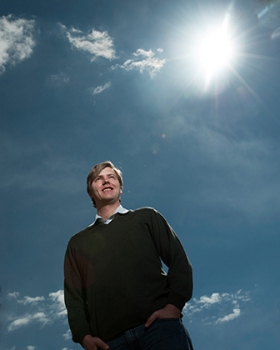Apr 18 2014
Ricky Egeland had just passed an important milestone when he learned he had won a major fellowship to continue studying the sun.
 Ricky Egeland, an MSU graduate student in solar physics, is the 2014 winner of the Newkirk Fellowship from the High Altitude Observatory in Boulder, Colo. (MSU photo by Kelly Gorham).
Ricky Egeland, an MSU graduate student in solar physics, is the 2014 winner of the Newkirk Fellowship from the High Altitude Observatory in Boulder, Colo. (MSU photo by Kelly Gorham).
“It’s really exciting,” the Montana State University graduate student said of recently winning a 2014 Newkirk Fellowship from the High Altitude Observatory (HAO) in Boulder, Colo.
The only recipient this year and the first winner from MSU, Egeland learned about the fellowship just moments after passing the oral examination for his doctorate in physics. The Newkirk Fellowship will continue until he completes his Ph.D., which he expects will take two or three more years. The fellowship will take him to Boulder, but he will remain an MSU graduate student.
Newkirk Fellowships are awarded on the basis of academic excellence, scientific potential and the compatibility of the student’s interests with current research at the observatory. The HAO conducts research and provides support and facilities in the areas of atmosphere, ionosphere and magnetosphere, long-term solar variability, and solar transients and space weather.
“Ricky won this fellowship based on a proposal he wrote to study sun-like stars, in particular their magnetic cycles, in order to better understand and ultimately predict the solar cycle,” said his MSU adviser, solar physicist Piet Martens.
Phil Judge, who serves on Egeland’s Ph.D. committee and told Egeland about his fellowship, will be Egeland’s supervisor at the High Altitude Observatory.
“The first step will be for Ricky to gather the multitude of data available on this subject into a single easily accessed database for the community to use,” Martens said. “Ricky is uniquely qualified for that because he has been an information technology manager at CERN in Geneva prior to attending MSU, working with databases orders of magnitude larger than the solar-stellar one.”
Egeland, a native of East Grand Forks, Minn., graduated from the University of Minnesota, Twin Cities, in 2003. He then became a software developer at the European Organization for Nuclear Research (CERN) and worked in Switzerland until 2010. After working briefly in Brazil at the Observatório Nacional in Rio de Janeiro, Egeland came to MSU.
The Newkirk Fellowship will allow him to study magnetic cycles of sun-like stars to better understand the dynamo mechanism responsible for these cycles, Egeland said. Scientists have long known that the solar cycle is 11 years on average, with the sun transitioning from periods of low activity at solar minimum to high activity at solar maximum. Those of other sun-like stars, however, range between three and 25 years, with some being irregular and some appearing to be devoid of magnetic activity. Solar activity -- which can include solar flares and solar wind -- can disrupt communication and power systems on Earth.
“In order to come to a more full understanding of long-term dynamic behavior of the sun, we must consider the sun in the context of similar stars, building a statistical sample of sun-like stars which are at different states of activity and evolution,” Egeland said.
The field of astrophysics has interested him ever since high school when he read Stephen Hawking’s book, “A Brief History of Time,” Egeland said.
“If you read that book, you can’t believe what’s written there. It seemed like unbelievable magic – black holes, arrow of time, relativity,” Egeland said, adding that the book motivated him to study physics in order to find out if any of those fantastic ideas could possibly be true.
Martens said he and Judge see Egeland’s project as a starting point for further collaborations between MSU and the HAO.
“We are only a day’s drive apart, have overlapping scientific interests and complementary strengths,”Martens said. “Both HAO and MSU have leading experts in solar physics on their staff, the HAO operates several world-class solar observatories, and the MSU Solar Group has a large group of very talented students, eager to work with the best people, data and computer resources available.